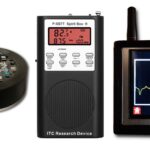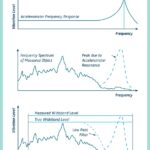By “Spec“, Electro-tech-online.com forum member
Magnetic theory can get a bit convoluted and before you know where you are, you can end up knee-deep in variables, constants, differentials, and integrals.This article reduces the theory down to a simple formula which, hopefully, will give you a feel for electromagnets and allow you to easily design a simple direct current (DC) rod electromagnet with a defined field strength at its pole faces.
 Providing the radius of the electromagnet core is no more than a tenth of the core length, the equations will be reasonably accurate (this caveat applies to most formulae for electromagnets).
Providing the radius of the electromagnet core is no more than a tenth of the core length, the equations will be reasonably accurate (this caveat applies to most formulae for electromagnets).
Many people will be familiar with fridge magnets, which typically have a magnetic field density of 5 mili Teslas. So, for reference, the design of a similar strength electromagnet is described in this article. Bear in mind though that a fridge magnet is effectively many magnets joined, so the magnetic surface comprises alternate north and south poles. By comparison, the earth’s magnetic field strength averages µ45 Teslas and the magnetic strength in the coil gap of a loudspeaker is typically 1.7 Teslas.
Magnetic Theory
This article does not go into the physics of the fields generated by the flow of an electric current in a straight conductor. Instead, it cuts straight to the chase and deals with the practical unit of magneto motive force (MMF) associated with electromagnets, the ampere-turn (AT).
Quite simply, the MMF is the number of turns multiplied by the current flowing through the turns. So, if you had 10 turns with 1 Amp flowing through them, you would have an MMF of 10 turns * 1 Amp = 10 Amp turns. Alternatively, if you had 100 turns with 0.1A flowing through them, then the MMF would still be 10AT.
We then calculate the MMF density (H) by dividing the MMF by the length of the electromagnet core in meters. So if your electromagnet is 0.02m (2cm) long, H would be 10AT/0.02M =500AT per meter. But H will not be used in the practical formula that described below. Instead, the AT and electromagnet length will be used directly, as these are the parameters you will need to design and build an electromagnet.
It is fairly common knowledge that opposite magnetic poles attract each other and like poles repel.

Simple Electromagnetic Formula:
B = (1.257 * 10^-6 * Ur * I * N)/L (f1)Where:
B: Magnetic field strength, at the pole faces, in Teslas (t).
1.257 * 10^6: Absolute permeability of a vacuum, a physical constant (see ADDENDUM).
Ur: Relative permeability of core (see ADDENDUM).
I: Current in Amps flowing through coil.
N: Number of turns of wire comprising the coil.
L: Length of core in meters.
This section describes the design of a rod electromagnet with a magnetic field density similar to a typical refridgerator magnet.
(1) Core material: electrical steel (Ur= 4,000)
(2) Current (I): 4 mA (0.004A)
(3) Number of turns (N): 10
(4) Core length: 0.02m (2cm)Thus, from (f1), B = (1.257 *10^-6 * 4,000 * 4*10^-3 * 10)/0.02 = 5 mt
Permeability
Permeability is the ability of a material to increase the magnetic field from a given MMF. The reference point is a vacuum (free space and dry air have essentially the same permeability as a vacuum), which has an absolute permeability of 4 * Pi * 10^-7 (~1.257 * 10^-6) Henrys per meter. Don’t worry too much about this. Just accept it as a physical constant that you plug into the formula for an electromagnet.All other materials have a permeability relative to a vacuum, known as a material’s relative permeability, (Ur). Below is a list of commonly-used ferromagnetic (high Ur) materials:
– nickel/zinc ferrite: 16 to 640 (328 average)
– manganese/zinc ferrite: 640 to 1,000 (820 average)
– electrical steel (transformer laminations): 4,000
– mumetal: 20,000 to 50,000 (35,000 average)Apart from the ferromagnetics, most materials have a Ur close to 1.You may be wondering if electrical steel has such a high Ur, why bother with the other electromagnetic materials. The answer is that there are other factors to take into consideration when selecting a core material, losses with frequency and magnetic saturation being the main two factors. Sometimes electromagnets may even have an air core.Right-hand grip rule
We can derive the polarity of the magnetic poles of an electromagnet by using the right-hand grip rule: grip the coil with the right hand with the fingers pointing in the direction of conventional current flow in the coils and the thumb will point to the north pole of the coil.
In Figure 1, showing the cross-section of a coil, the current flowing into the coil is indicated by a cross, and the current flowing out of the coil is shown by a dot as if a dart were moving through a tube.
By convention, the magnet lines of force are considered to flow from the north pole to the south pole.
Inverse square law
The magnetic field strength follows the inverses square law, where the magnetic field strength is inversely proportional to the square of the distance from the pole face: B = 1/D^2.
BH CURVE
https://www.electronics-micros.com/electrical/b-h-curve/
HYSTERESIS & LOSSES
https://www.electronics-micros.com/electrical/b-h-curve/
LINKS
(1) Magnetic Field
(2) Tesla
(3) Permeability:
(4) Refrigerator magnet:
(5) Solenoid:
(6) Earth’s magnetic strength:
(7) Magnet:
(8) Example magnetic strengths







“the earth’s magnetic field strength averages 45 Teslas”
is wrong; the link you have given in (6) clearly says that the earth’s magnetic field is of the order of microteslas.
Article tells “the earth’s magnetic field strength averages 45 Teslas”, Apparently the µ prefix has been lost somehow,
Thank you, Frank. The prefix did drop off. I have corrected it.
cheers,
Aimee